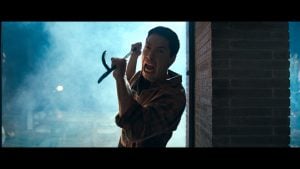How AI Is Changing Special Effects in Sci-Fi and Fantasy
Introduction — Where Tech Meets Imagination
Special effects have always been the magic wand behind sci-fi and fantasy. From the practical models in Star Wars (1977) to the groundbreaking CGI of Avatar (2009), each technological leap has opened new narrative dimensions. Today, another revolution is underway—driven not by artists alone, but by algorithms. Artificial Intelligence is entering the VFX pipeline with unprecedented impact.
This article explores how AI is reshaping the landscape of special effects in science fiction and fantasy media, analyzing the tools, ethics, and creative frontiers being rewritten in real time.
The Traditional VFX Pipeline — And Its Limitations
Before AI, creating special effects was time-consuming, labor-intensive, and often involved dozens of departments. Motion capture, green screen compositing, 3D modeling, and frame-by-frame animation made even short CGI sequences take months to complete.
For studios working on sci-fi and fantasy projects with expansive worlds, alien creatures, magical effects, and futuristic technologies, the cost and complexity could become a limiting factor. AI, however, is beginning to automate—and augment—these tasks.
Where AI Makes the Difference
AI-Powered Generative Models
Tools like GANs (Generative Adversarial Networks) and diffusion models can now generate realistic textures, backgrounds, and even full-motion environments from scratch. This is particularly useful in sci-fi landscapes like interstellar space, alien planets, or dystopian cityscapes.
Studios like Disney and Industrial Light & Magic (ILM) have begun experimenting with AI to render background assets, simulate lighting effects, and build high-volume datasets for animation training.
Facial Mapping and Digital Doubles
AI is also transforming facial animation. With deep learning-based motion transfer, actors can perform in short mocap sessions, and the AI automatically animates entire sequences across their digital doubles. This is critical in fantasy and sci-fi franchises where actors play hybrid or non-human roles.
For example, The Mandalorian famously used deepfake and AI face reconstruction to bring back young Luke Skywalker without relying heavily on conventional CGI modeling.
ask Overchat AI — The New Creative Partner?
Halfway through the production process, many VFX artists and scriptwriters now ask Overchat AI or other similar AI assistants to generate concept sketches, storyboard variations, or even test renders of alien creatures or space tech.
These generative systems aren’t just tools—they are collaborators. They offer dozens of iterations in seconds, helping creators visualize speculative worlds without burning weeks in pre-production.
Crucially, these AIs learn style preferences. Want a dark cyberpunk metropolis with rainfall physics? A flying biomechanical dragon with glowing runes? Feed the prompt once, fine-tune, and get a customizable foundation to build upon.
AI for Crowd Simulation and Battle Sequences
Intelligent Agents
In fantasy epics and sci-fi wars (think Game of Thrones, Dune, or Avengers), crowd scenes often require thousands of animated entities. Previously, this meant manually replicating and animating each group—an enormous task.
AI now handles this via behavioral modeling. Systems like Massive Software use AI agents that react dynamically to scripted events—running, fighting, retreating, all autonomously. Each “digital extra” has its own logic, giving organic depth to battlefields and crowds.
Real-Time Rendering with AI Upscaling
Epic scenes once needed long post-production rendering times. Today, with AI-based upscaling (like NVIDIA DLSS or AMD FSR), VFX teams can render assets at lower resolutions and let AI sharpen them for final output—saving resources without compromising quality.
Changing the Role of the Artist
One of the most debated consequences of AI in visual storytelling is the redefinition of artistic labor.
Instead of hand-painting textures or modeling every creature limb, artists now supervise, direct, and train models. The AI does the heavy lifting, while the human ensures coherence, emotion, and artistic intent.
According to VFX lead Daniel Guertin (Weta FX), “AI doesn’t replace the artist—it amplifies the artist’s vision. It’s like having 100 junior artists that never sleep.”
Risks and Ethical Dilemmas
Deepfakes and Digital Resurrection
One of the most controversial uses of AI is posthumous acting—recreating deceased actors for cameos or full roles. While this allows for storytelling continuity (see Carrie Fisher in Star Wars), it raises moral questions about consent and creative integrity.
Bias in Generative Systems
AI systems can unintentionally encode biases present in training data—producing humanoid aliens or fantasy figures that reinforce racial or gender stereotypes.
Studios must vet training datasets and involve diverse design teams to avoid replicating harmful norms in speculative fiction.
Future Frontiers — Real-Time AI FX in AR/VR
As AR/VR storytelling platforms evolve, AI will enable interactive special effects in real time. Imagine watching a fantasy series where magical weather, glowing spells, and shape-shifting environments adapt based on your reactions—powered by emotion-sensing AIs.
Meta’s Reality Labs, for example, is prototyping dynamic VFX in VR spaces where the narrative adjusts depending on your gaze, pulse, or voice tone.
Conclusion — Toward a New Visual Language
Sci-fi and fantasy have always stretched the boundaries of what’s visually possible. With AI now firmly integrated into the VFX pipeline, these genres are entering a golden age of speculative visual storytelling.
But with great power comes greater responsibility. As we train machines to dream with us, we must also teach them what not to imagine—and what stories are still best told by human hands.
The future of cinematic magic is not just in code or canvas—it’s in the collaboration between vision and verification, between the artist’s intent and AI’s potential.
Sandra Larson is a writer with the personal blog at ElizabethanAuthor and an academic coach for students. Her main sphere of professional interest is the connection between AI and modern study techniques. Sandra believes that digital tools are a way to a better future in the education system.





